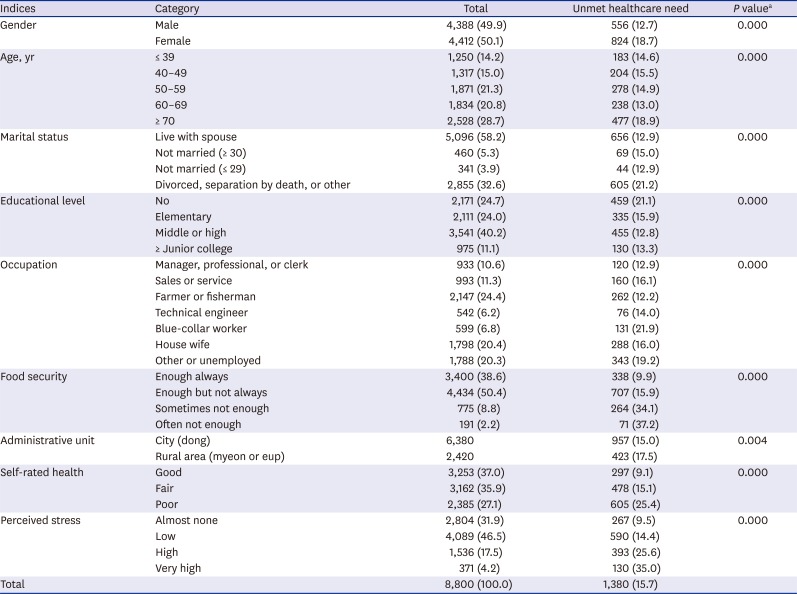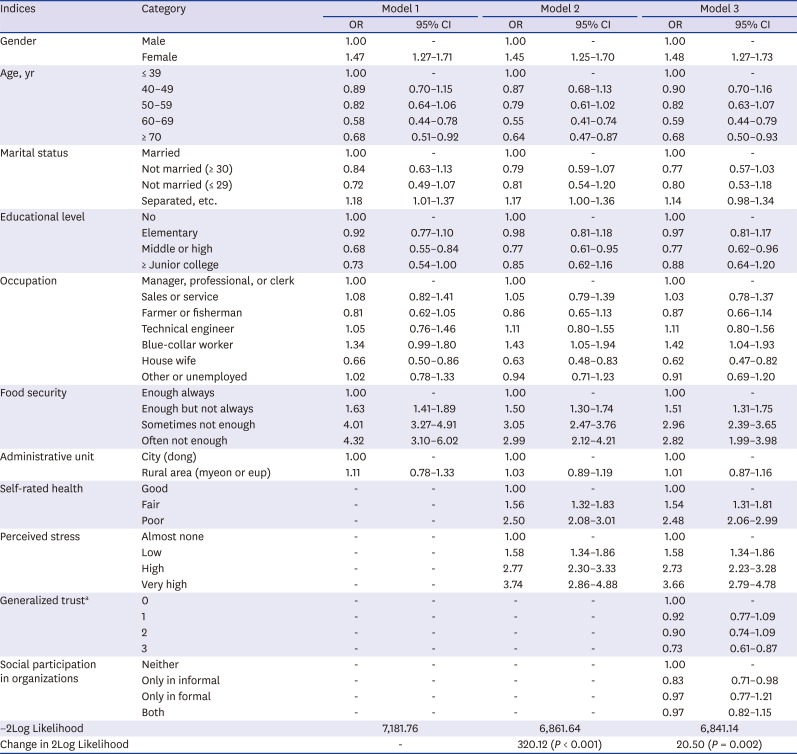1. Morgan A, Swann C. Social Capital for Health: Issues of Definition, Measurement and Links to Health. London, United Kingdom: Health Development Agency;2004.
2. Folland S. An economic model of social capital and health. Health Econ Policy Law. 2008; 3(Pt 4):333–348. PMID:
18793476.

4. Nieminen T, Prättälä R, Martelin T, Härkänen T, Hyyppä MT, Alanen E, et al. Social capital, health behaviours and health: a population-based associational study. BMC Public Health. 2013; 13:613. PMID:
23805881.

6. Delhey J, Newton K. Who trusts?: the origins of social trust in seven societies. Eur Soc. 2003; 5(2):93–137.

7. Mohseni M, Lindström M. Social capital, trust in the health-care system and self-rated health: the role of access to health care in a population-based study. Soc Sci Med. 2007; 64(7):1373–1383. PMID:
17202025.

8. Lindström M. Social capital, the miniaturisation of community and self-reported global and psychological health. Soc Sci Med. 2004; 59(3):595–607. PMID:
15144768.

9. Musai M, Mehrara M, Miri S, Sedaghati FN. Relationship of social trust and social participation. Int J Manag Sci. 2014; 2(7):284–295.
10. Mohseni M, Lindström M. Social capital, political trust and self rated-health: a population-based study in southern Sweden. Scand J Public Health. 2008; 36(1):28–34. PMID:
18426782.

11. Nummela O, Sulander T, Rahkonen O, Karisto A, Uutela A. Social participation, trust and self-rated health: a study among ageing people in urban, semi-urban and rural settings. Health Place. 2008; 14(2):243–253. PMID:
17686647.

12. Lindström M, Axén E, Lindström C, Beckman A, Moghaddassi M, Merlo J. Social capital and administrative contextual determinants of lack of access to a regular doctor: a multilevel analysis in southern Sweden. Health Policy. 2006; 79(2-3):153–164. PMID:
16414146.

13. Bryant T, Leaver C, Dunn J. Unmet healthcare need, gender, and health inequalities in Canada. Health Policy. 2009; 91(1):24–32. PMID:
19070930.

14. Kim JR, Jeong B, Park KS, Kang YS. Association of social capital at the individual level with physical activity in communities with high mortality in Korea. Health Promot Int. 2017; 32:850–859. PMID:
27020574.

15. Bajekal M, Purdon S. Social Capital and Social Exclusion: Development of a Condensed Module for the Health Survey for England. London, United Kingdom: National Centre for Social Research;2001.
17. Allin S, Grignon M, Le Grand J. Subjective unmet need and utilization of health care services in Canada: what are the equity implications? Soc Sci Med. 2010; 70(3):465–472. PMID:
19914759.

18. Nelson CH, Park J. The nature and correlates of unmet health care needs in Ontario, Canada. Soc Sci Med. 2006; 62(9):2291–2300. PMID:
16431003.

19. Ministry of Health and Welfare, Korea Centers for Disease Control and Prevention. Korea Health Statistics 2010: Korea National Health and Nutrition Examination Survey (KNHANES V-1). Cheongwon, Korea: Korea Centers for Disease Control and Prevention;2011.
21. Quail JM, Addona V, Wolfson C, Podoba JE, Lévesque LY, Dupuis J. Association of unmet need with self-rated health in a community dwelling cohort of disabled seniors 75 years of age and over. Eur J Ageing. 2007; 4(1):45–55. PMID:
28794771.
22. Laporte A, Nauenberg E, Shen L. Aging, social capital, and health care utilization in Canada. Health Econ Policy Law. 2008; 3(Pt 4):393–411. PMID:
18793479.

23. Ministry of Health and Welfare, Korea Centers for Disease Control and Prevention. Korea Health Statistics 2012: Korea National Health and Nutrition Examination Survey (KNHANES V-3). Cheongwon, Korea: Korea Centers for Disease Control and Prevention;2013.
24. Allin S, Masseria C. Unmet need as an indicator of health care access. Eurohealth (Lond). 2009; 15(3):7–9.
25. Sibley LM, Glazier RH. Reasons for self-reported unmet healthcare needs in Canada: a population-based provincial comparison. Healthc Policy. 2009; 5(1):87–101.

26. Kim J, Kim TH, Park EC, Cho WH. Factors influencing unmet need for health care services in Korea. Asia Pac J Public Health. 2015; 27(2):NP2555–69. PMID:
23858512.

27. Amirkhosravi N, Adib-Hajbaghery M, Lotfi MS, Hosseinian M. The Correlation of social support and social participation of older adults in Bandar Abbas, Iran. J Gerontol Nurs. 2015; 41(6):39–47. PMID:
25849064.

28. Devillanova C. Social networks, information and health care utilization: evidence from undocumented immigrants in Milan. J Health Econ. 2008; 27(2):265–286. PMID:
18242742.

30. Ueshima K, Fujiwara T, Takao S, Suzuki E, Iwase T, Doi H, et al. Does social capital promote physical activity? A population-based study in Japan. PLoS One. 2010; 5(8):e12135. PMID:
20808822.

31. Samek DA, Laporte A, Nauenberg E, Shen L, Coyte PC. The effect of social capital on the use of general practitioners: a comparison of immigrants and non-immigrants in Ontario. Healthc Policy. 2012; 8(1):49–66. PMID:
23968603.









 PDF
PDF Citation
Citation Print
Print




 XML Download
XML Download